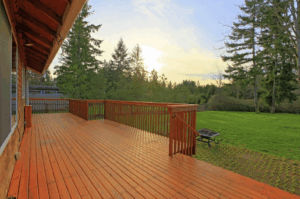Most people who want to build a patio have a difficult time choosing which material to use in building that patio.
Concrete and stone are the most commonly selected options in general, and they’re both great, but deciding between a concrete vs stone patio can be a challenge because most people simply haven’t thought much about it before.
The truth is that both materials are great, but for different applications and situations. This article is to help you review some of the needs you may have and which of these two building materials might be best suited to them.
We’ll cover aesthetics because many people have strong preferences for one or the other in their own situations, but we’ll mostly be going over the different factors you should weigh with regard to functionality and other practical considerations.
Durability
Concrete is renowned for its resilience in various weather conditions, making it a popular choice for homeowners who experience extreme temperature fluctuations.
Its ability to withstand intense heat, cold, and heavy rainfall without cracking or warping ensures that a concrete patio maintains its integrity over the years.
Modern advances in concrete mixes and sealers have further enhanced its durability, allowing it to better resist stains and surface wear.
On the other hand, stone patios offer a natural strength that is hard to beat.
This inherent longevity means a stone patio can last decades, often outliving its concrete counterparts.
Stone’s natural composition provides an advantage in resistance to erosion and fading, maintaining its original beauty over time without significant deterioration.
Aesthetics
Concrete offers a wide selection of design possibilities for any outdoor space into a personalized oasis.
With stamping, staining, and coloring techniques, concrete can mimic more expensive materials like brick, tile, or even natural stone, providing homeowners with high-end looks at a fraction of the cost.
The ability to customize patterns and colors means you can create a patio that merges harmoniously with your existing landscape.
And that’s true whether you prefer a modern style or a more traditional appearance.
On the other hand, the allure of stone lies in its natural beauty and unique textures.
Each piece of quarried stone is distinct, offering a one-of-a-kind look that manufactured materials can’t replicate.
Stone patios exude timeless elegance and bring an organic feel to outdoor spaces.
Whether it’s the earthy tones of flagstone, the rustic charm of cobblestone, or the sleek sophistication of slate, stone can enhance the aesthetic appeal of any garden or backyard setting.
Its inherent variations in color and texture make it an excellent choice for those looking to create a harmonious connection between their patio and the surrounding natural environment.
Maintenance
When it comes to maintaining a concrete vs stone patio, homeowners should consider the routine care each material demands.
Concrete patios generally require less frequent maintenance but do benefit from regular cleaning to prevent stains and mold buildup.
One of the appealing aspects of concrete is the option for a stamped design, which can imitate the appearance of stone or brick.
However, resealing a concrete patio every two to three years is advisable to keep everything looking fresh.
This preserves its appearance and protects against harsh weather conditions that could cause cracking or erosion over time.
On the other hand, the long-term maintenance needs for stone patios are often characterized by their natural resilience but come with their own set of requirements.
While natural stone benefits from its inherent strength and ability to resist wear, it may require more meticulous care to maintain its unique textures and colors.
Stones like limestone or sandstone can be more porous, necessitating occasional sealing to prevent water damage and staining (hopefully using eco-friendly sealers).
Installation Process
Regarding the installation process, a concrete patio often provides a smoother experience for those who prioritize efficiency and uniformity.
The steps involved typically start with preparing the ground by leveling and compacting the soil.
Next, forms are set up to shape the patio’s perimeter, followed by pouring and spreading the concrete mix evenly within these forms.
After this, the surface is leveled and smoothed out, sometimes incorporating texture or patterns for added flair.
Once the concrete has cured, which can take several days, the patio is ready for use.
This streamlined process makes concrete a popular choice among DIY enthusiasts seeking straightforward patio customization options.
On the other hand, installing a stone patio requires a bit more finesse and patience due to the natural variability of the materials.
The first step involves preparing a stable base, similar to concrete, but often requires additional layers of gravel or sand for proper drainage.
Each stone must then be placed and fitted together like an intricate puzzle, ensuring they are level and secure.
Challenges can arise from irregular stone shapes and sizes, demanding careful planning and adjustment during installation.
However, this effort pays off in the end, offering a one-of-a-kind aesthetic that beautifully complements various landscape styles.
Environmental Impact
Unfortunately, concrete production contributes a lot of carbon to the environment due to the energy-intensive process of manufacturing cement, which is a key component.
However, eco-friendly advancements have made strides in reducing this impact.
For example, incorporating fly ash or slag into concrete mixes can reduce the reliance on traditional cement and, thus, decrease emissions.
Additionally, permeable concrete options are available, which allow rainwater to filter through rather than run off, reducing erosion and promoting groundwater recharge.
On the other hand, natural stone stands out for its inherent sustainability.
Stone is naturally occurring and requires less processing than manufactured products like concrete.
Stone’s environmental footprint largely depends on its sourcing practices; locally sourced stone reduces transportation emissions and supports regional economies.
When possible, ensure that stone is extracted responsibly from quarries that adhere to sustainable practices, minimizing habitat disruption and preserving biodiversity.
Making the Right Choice for Your Patio
Choosing between a concrete vs stone patio involves weighing several factors.
Ultimately, the best choice hinges on your personal preferences and practical considerations.
Consider the look you want to achieve, the effort you’ll invest in maintenance, and your budget.
Both materials offer distinct advantages, so reflect on what matters most to you and your lifestyle.
By taking these factors into account, you’ll be well-equipped to make an informed decision about the design of your outdoor area into a stunning and functional retreat.


